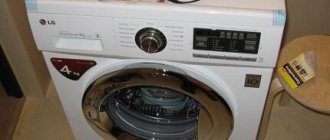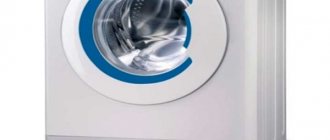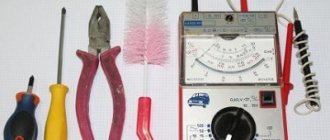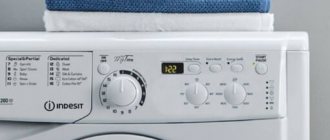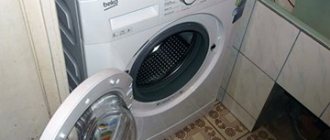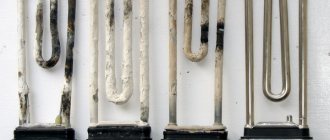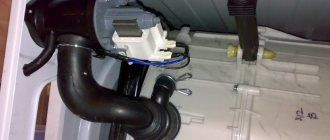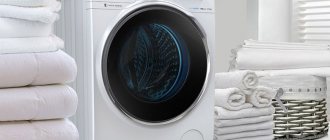If the washing machine does not draw or drain water well, then you need to clean the filters.
Samsung devices have two filters - fill and drain. They perform a protective function, protecting the washing machine from debris during water intake and during washing.
Timely cleaning allows the device to operate normally and will also avoid more serious problems that will require calling a specialist to fix.
Function of filters and their location
An inlet filter is needed to clean tap water from large particles that can harm the mechanical parts of the equipment. It is located where the inlet hose and valve connect.
The inlet filter consists of a valve with a fine mesh. It effectively traps small particles in the water.
Drain filters in horizontal-loading Samsung washing machines are located on the front wall, in the lower right part. They are usually located under a rectangular cover, and in older models - under a removable plastic bezel.
Attention! On top-loading machines, the exhaust filter is located on one of the sides of the machine. But now on the Russian market it is practically impossible to find top-loading SMA from Samsung.
This article will tell you which washing machine is better to choose - Bosch or Samsung, LG or Samsung - this article.
Causes of blockages
The waste fluid drainage system can become clogged mechanically or naturally. A clear sign of a clogged hose is slow drainage of water after washing or rinsing. A program failure in which the machine does not automatically switch to the rinse or spin phase indicates a blockage.
Small items that sometimes remain in pockets can cause drain blockages.
When the clearance is critically low, the machine's drainage system is completely blocked. There may be several reasons:
- small objects get into the filtration system of the drainage hose: buttons, hooks, coins, pins, fasteners that come off clothes or fall out of pockets;
- lint and threads gradually accumulate, dust and dirt from washed clothes, fur from furry pets, grease, soap and limescale deposits, the lumen of the hose becomes overgrown and decreases.
When is cleaning necessary?
The first indicator by which you can determine the need to clean the garbage trap is a problem with draining the water. In this case, the washing machine stops washing and gives an error signal.
In Samsung devices, a problem with water drainage is indicated by the following codes on the panel:
- E2 - in cars manufactured before 2007;
- 5E - in modern devices.
Error 5E is often confused with E5, which signals a problem in the heating system.
If the device does not have a display, then a constantly lit 40C indicator will help you find out if the filter is clogged. The lights for all operating modes also flash.
When the inlet filter is clogged, the following symptoms are observed:
- After starting the wash, the water takes a very long time to collect;
- The device displays an error code after several attempts to fill with water.
In these cases, it is necessary to clean the inlet filter. Instructions on how to clean the filter in a washing machine with your own hands are presented here, the designation of icons on a Samsung washing machine with a description and photo is here.
What happens if the filter is not cleaned?
The drain filter is a very important component for the normal functioning of the unit. The filter element prevents hair, lint and other debris from entering the pump.
Coins, hairpins, and keys can also get into the drum. In some cases, buttons and rhinestones come off from clothing. The filter element will prevent them from damaging the pump.
REFERENCE . If cleaning is not carried out in a timely manner, a blockage will appear. Because of this, the washing machine will not be able to drain the water.
People who do not clean the drain filter may experience the following problems:
- Discharge of waste water will become difficult. If this is not corrected, the device will soon completely stop discharging waste into the sewer.
- Some of the debris from the filter will still get into the pump, which will lead to its breakdown. A large object is likely to break the impeller. The drain pump will have to be replaced.
- There will be an unpleasant odor from the machine. This aroma will spread to your washed clothes.
In the case of a fill filter, everything is much simpler. Water will simply flow into the tank worse.
Self-cleaning washing machine
The eco drum cleaning function does not require the addition of any cleaning agents or disinfectants; the machine cleans everything on its own. The cleaning cycle is carried out at a temperature of 70 degrees for 90 minutes.
This allows you to disinfect the inside of the device, remove scale, mold and unpleasant odors - it is impossible to change these parameters, they are set automatically by the electronics of the washing machine.
The eco-drum cleaning program makes it possible not only to maintain hygiene inside the device, but also significantly extends the performance of the unit. In addition, by regularly cleaning the washing machine, you will save energy, because the electric heater is also cleaned of plaque adhering to it, and, therefore, heats the water much faster and more efficiently.
Frequency of prevention
Severely clogged drains lead to problems with the pump, so cleaning should not be delayed. It is optimal to clean this element every 3-4 months.
The fill filter does not require regular cleaning. It is carried out as the water supply to the washing machine deteriorates. If it begins to build up slowly, the mesh is cleaned.
Do you like your Samsung washing machine?
Not really
Cleaning the drain hose
The water is drained through a drain hose, which becomes no less contaminated than other elements of the machine. It can be cleaned using the same means, only pouring, for example, soda, must be done directly into the drum. If the drain is completely clogged, it can be cleaned mechanically by removing the drain hose using a Kevlar cable.
Drain hose
Kevlar rope for cleaning drain hose
To summarize the above, we can say that the service life of an automatic washing machine depends on quality care and timely cleaning. You can clean the machine either at home or by calling specialists to your home. All cleaning products are available, easy to use, and do not harm the elements of the unit. The most common are citric acid, vinegar, soda, and white. The most common contaminants are mold, limescale, and scale.
Step by Step Actions
If you follow the step-by-step instructions, you will be able to complete the task very quickly. Having completed the work once, it will not cause any difficulties in the future.
Tools and equipment
To clean the filter you will need to prepare the following:
- flat screwdriver;
- flashlight;
- pliers;
- small scissors or tweezers;
- old toothbrush;
- a container for collecting water or a rag;
- lemon acid.
Preparing for cleaning
Before starting cleaning, certain preparatory measures should be taken:
- Turn off the water on the machine.
- Be sure to disconnect the device from the network.
- Prepare all the necessary tools.
- Remove the hatch cover using a screwdriver or knife.
This completes the preparatory work. You can remove the filter and proceed to cleaning.
Troubleshooting Possible Problems
The process of cleaning the drain filter does not always go smoothly. During the procedure, you may encounter the fact that the part cannot be removed. This often happens due to its infrequent extraction. Foreign objects or scale may interfere with removal.
Advice! To prevent damage to the filter, carefully tap the filter cover. If this does not help, take pliers. But at the same time, it is necessary to control the pressure so as not to break the plastic protrusion when you take it out. You should rotate it carefully, without sudden movements.
Process
The process of removing and cleaning the waste filter:
- The part is unscrewed using a counterclockwise rotational motion. If cleaning is carried out in emergency mode, you need to lay out a rag in advance to prevent water from spreading across the floor.
- After unscrewing, the filter is washed under running water. It is advisable to use an old toothbrush to remove dirt more thoroughly. If hair and threads are tangled in the mesh, they need to be carefully cut off with small scissors.
- When the filter is clean, do not rush to install it back. First you need to use a flashlight to inspect the hole in which the part was located. The impeller of the drain pump should also be cleaned; hair, threads and all debris should be removed from it. It is convenient to use tweezers for this.
- After all the dirt has been removed, install the filter back by screwing it clockwise. It must be screwed tightly. After this, close the hatch.
REFERENCE . If there is a lot of mold and scale on the part, you can use citric acid. The filter is soaked in a weak solution for 2 hours, then washed under running water.
The procedure for cleaning the filling filter is quite simple; even a woman who is not familiar with the structure of the washing machine can cope with it.
But you need to follow the sequence of steps described:
- Unplug the device from the outlet and turn off the tap supplying water to the machine.
- Unscrew the hose and disconnect it from the housing to gain access to the filter. Most often, this procedure is performed manually, but if you are not strong enough, you can use pliers. There is always water left in the hose, so you need to substitute some kind of container or rag.
- Gently pinch the mesh with pliers and pull. It comes out very easily.
- Rinse the filter under water. If this is not enough, the mesh should be soaked for 1 hour in a solution of a cleaning agent, such as citric acid. For 1 glass of warm water you need to dissolve 1 tsp. substances. It is important that the water is not hot. High temperatures may cause the plastic to become deformed, after which the inlet filter will have to be replaced.
- After this, the mesh is inserted back into the hole until it stops.
- Next, screw the drain hose and open the water. It is necessary to check that there is no water leaking at the connection point.
- The washing machine is turned on and any program is started to make sure that water is poured into the tank normally.
Means used
You can remove small dirt from the filter using regular running water. But if there is no cleaning for a long time, the use of cleaning products may be required.
To remove contaminants, you can use folk recipes from improvised means:
- baking soda. It is necessary to dissolve 50 g of this powder in one liter of warm water and soak the filter mesh with this composition for 15-20 minutes. Rinse the part with clean water using a sponge or toothbrush and dry;
- table vinegar. Dissolve one glass of 9% vinegar in one liter of water. Soak the removed part in this solution for 5-6 hours. Clean with a brush and rinse with warm water. Read more about cleaning a washing machine with vinegar here;
- lemon acid. Pour a 50 g bag into the washing machine tank and turn it on without laundry to a program at 60 degrees. At the end of the cycle, unscrew the filter and remove loose dirt. This method is suitable for cleaning the heating element and preventing the appearance of an unpleasant odor.
Do you use traditional methods to clean your washing machine?
Not really
To eliminate serious contamination, the use of industrial and household chemicals will be required. The most effective drugs include:
- Pemolux. Its composition is similar to a mixture of soda and citric acid. For cleaning, soak the part in a concentrated solution of this powder for 15-30 minutes;
- Antiscale. This product prevents the deposition of limescale and destroys existing stains. To use, it is poured into the drum of the washing machine and a high-temperature wash cycle is turned on;
- Comet. It removes even the most severe dirt and copes with fungus and mold. Used in a similar way to Pemolux;
- Domestos. Eliminates all types of unwanted deposits. The gel is applied directly to the mesh and left for 10-15 minutes, then washed off with clean water;
- Silit. Removes scale and lime deposits, fights the source of unpleasant odors. It is used by analogy with Domestos in undiluted form.
How to check if the equipment is working after the procedure?
If the reinstallation of the debris catcher is done carefully, and the part fits tightly and evenly, then no problems should arise during operation of the device. But you should still check the drain system for leaks.
Important! The washing machine is plugged in and checked for leaks. To do this, turn it on in rinsing mode (without laundry).
Have you already cleaned your washing machine filters?
Not really
What problems might you encounter?
The filter may not unscrew or be pulled out, making it impossible for the user to clean it. Also, after the procedure, in some cases the filter element begins to leak.
The filter does not unscrew or cannot be pulled out
You may encounter one of the following problems:
- The filter cannot be unscrewed, the handle does not turn.
- The part only turns a quarter or half a turn before it gets stuck.
- The filter element is completely unscrewed, but cannot be pulled out.
The presented methods must be applied sequentially - if the previous option does not work, move on to the next one:
- If the cap does not unscrew, use a tool. There is a handle on the plug. You need to try turning it with pliers. But you should act very carefully so as not to break the filter.
- Tilt the machine back and lean it against the wall. After this, you need to tap your palm on the lid and next to it. Foreign objects may have blocked the filter. If they change their position, they will no longer block the part.
- Dismantle the drain pump, clean the volute and unscrew the required element. This is a complex method, so it should be used only if the previous two did not help.
The filter leaks after cleaning
If a puddle appears on the floor after cleaning, this indicates one of the following problems:
- the part is not completely screwed in;
- during installation, the filter element did not go along the thread;
- The rubber gasket is damaged.
The first two problems can be solved very easily. You just need to reinstall the filter. If the gasket is damaged, it will need to be replaced.
IMPORTANT . The worst thing is if the thread breaks. In this case, you will need to replace the filter or pump volute.
Cleaning both filters in a Samsung washing machine is very easy. This task can be completed in just a few minutes. If you use the device regularly, this procedure is mandatory to prevent malfunctions.
What to do if the filter cannot be removed even with some effort?
Sometimes, for various reasons, a filter that has been cleaned for a long time or has never been cleaned can become so stuck that it is impossible to unscrew it even with the help of serious physical force. And in this case, do not despair. The problem is completely solvable and not as hopeless as it may seem.
In this case, you can remove the entire structure along with the pump by getting to it from the inside. Once again, a reminder - if the filter is attached to the outside with screws, they must first be unscrewed!
After removing the structure, you can try to carefully unscrew the filter from the inside (possibly using certain tools). If you fail, you will have to carefully disassemble the entire structure on the table and remove it. Next, again, cleaning, assembly and installation is in reverse order.
Different washing machine manufacturers have different access options.
For example, Samsung, Whirlpool, Candy, Indesit and Ariston usually have no bottom at the bottom or it is removable. In this case, it is enough to place the car on its side and access to the drain pump is open.
Bosch and Siemens have the ability to remove the front panel of the case, and Electrolux has the rear panel.
Since we are talking about brands, it is worth noting that the same Bosch-Siemens, LG and Electrolux in most of their models (except for the most budget ones) are equipped with a drain tube on the drain filter.
This seemingly trifle makes cleaning the drainage system of washing machines much easier. And many Samsung models can display a code message on the display indicating that the filter is dirty.


